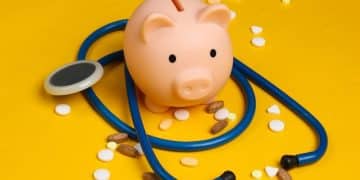Heart Disease Risk Reduction: US Adults Over 50 Lifestyle Plan

For US adults over 50, reducing heart disease risk hinges on adopting targeted lifestyle changes, including diet, exercise, stress management, and regular health check-ups, which cumulatively enhance cardiovascular well-being and longevity.
As we navigate life past the half-century mark, our focus often shifts towards preserving health and vitality. For many US adults over 50, a critical concern is the looming specter of heart disease, a leading cause of mortality. Yet, the power to significantly reduce this risk often lies within our daily choices.
Understanding Heart Disease Risk Over 50
As individuals in the United States age past 50, the risk of developing heart disease, encompassing conditions like coronary artery disease, heart failure, and stroke, begins to climb significantly. This increase is not merely a consequence of aging itself, but rather an accumulation of various risk factors over decades. While some factors, such as genetics, cannot be altered, a substantial portion are modifiable through conscious lifestyle choices. Understanding these prevalent risk factors is the first crucial step toward effective prevention and management.
One of the primary age-related changes is the stiffening of arteries, a process known as arteriosclerosis. This natural physiological change, combined with a potential lifetime of unhealthy habits, can lead to atherosclerosis, where plaque builds up inside the arteries, narrowing them and restricting blood flow. This often goes unnoticed for years, slowly progressing until a critical event occurs, such as a heart attack or stroke. The cumulative effect of years of dietary choices, physical activity levels, and stress management techniques profoundly impacts the cardiovascular system’s resilience.
Common Risk Factors for Older Adults
Several key factors disproportionately affect adults over 50. Addressing these can have a profound impact on reducing heart disease risk.
- High Blood Pressure (Hypertension): Often called the “silent killer,” hypertension forces the heart to work harder, weakening it over time and damaging blood vessels. Its prevalence escalates with age, making regular monitoring essential.
- High Cholesterol: Elevated levels of LDL (“bad”) cholesterol contribute directly to plaque formation in arteries. Dietary habits play a significant role here, as does the body’s natural cholesterol production which can be influenced by age and genetics.
- Diabetes: Both Type 1 and Type 2 diabetes significantly increase heart disease risk due to high blood glucose levels damaging blood vessels and nerves that control the heart. Type 2 diabetes often develops later in life and is closely linked to lifestyle.
- Obesity and Overweight: Excess body fat, particularly around the abdomen, is linked to higher blood pressure, cholesterol, and the development of Type 2 diabetes, all major risk factors for heart disease.
Beyond these, other factors include physical inactivity, chronic stress, smoking, and excessive alcohol consumption. The collective presence of multiple risk factors exponentially increases the overall threat. For instance, an individual with both high blood pressure and diabetes faces a much higher risk than someone with only one of these conditions. Therefore, a holistic approach to lifestyle modification is not just beneficial, but often critical for adults over 50 aiming to safeguard their heart health.
Awareness of these risks acts as a powerful motivator. Regular medical check-ups, including screenings for blood pressure, cholesterol, and blood sugar, become indispensable tools for early detection. Many of these conditions are asymptomatic in their early stages, making proactive monitoring the only way to catch them before significant damage occurs. Empowering oneself with this knowledge allows for informed decisions and proactive steps toward a healthier future.
Understanding the interplay of these risk factors is vital. For example, obesity can lead to both high blood pressure and diabetes, creating a cascading effect on cardiovascular health. Similarly, physical inactivity exacerbates weight issues and makes blood pressure and blood sugar control more challenging. Recognizing these connections helps in formulating a comprehensive strategy for risk reduction.
Embracing a Heart-Healthy Diet
The adage “you are what you eat” holds profound truth, especially concerning cardiovascular health for individuals over 50. A strategic dietary approach can be one of the most powerful tools in preventing and managing heart disease. Shifting away from processed foods and embracing whole, nutrient-dense options becomes paramount, not just for weight management, but for directly influencing cholesterol levels, blood pressure, and overall arterial health.
The Mediterranean Diet Philosophy
Often lauded as the gold standard for heart health, the Mediterranean diet isn’t a strict regimen but rather a philosophy of eating centered around the traditional dietary patterns of countries bordering the Mediterranean Sea. Its core principles are highly beneficial for the cardiovascular system:
- Emphasis on Plant-Based Foods: Abundant intake of fruits, vegetables, whole grains, nuts, and legumes provides fiber, antioxidants, and a wide array of vitamins and minerals. Fiber, in particular, is crucial for lowering cholesterol and promoting a healthy digestive system.
- Healthy Fats: Olive oil is the primary source of fat, being rich in monounsaturated fats. Avocados and nuts also contribute beneficial fats, which can help reduce bad cholesterol (LDL) and increase good cholesterol (HDL).
- Lean Proteins: Fish and seafood are consumed regularly, providing omega-3 fatty acids known for their anti-inflammatory and heart-protective properties. Poultry, eggs, and dairy are consumed in moderation, while red meat intake is limited.
- Limited Processed Foods and Sugars: The diet naturally minimizes highly processed foods, refined grains, and added sugars, which are major contributors to inflammation, weight gain, and insulin resistance.
Adopting this eating pattern can lead to significant improvements in blood pressure, cholesterol profiles, and blood sugar control. It’s not about deprivation, but about prioritization—focusing on what you *can* eat abundantly rather than what you *can’t*.
Beyond the Mediterranean framework, general dietary guidelines are also critical. Reducing sodium intake is vital for managing blood pressure, as excess sodium can lead to fluid retention and increased strain on the heart. Many processed and packaged foods are surprisingly high in sodium, so reading food labels becomes an essential habit.

Controlling portion sizes is another often overlooked aspect. Even healthy foods, when consumed in excess, can contribute to weight gain, putting extra strain on the heart. Mindful eating, paying attention to hunger and fullness cues, can help in this regard. Furthermore, incorporating foods rich in potassium, such as bananas, spinach, and sweet potatoes, can help counteract the effects of sodium and support healthy blood pressure levels.
The transition to a heart-healthy diet doesn’t have to be drastic. Small, consistent changes often yield the most sustainable results. For example, substituting whole-grain bread for white bread, snacking on nuts instead of chips, or swapping red meat for fish a few times a week can cumulatively make a substantial difference. Culinary exploration can make the process enjoyable, discovering new flavors and recipes that align with a heart-healthy philosophy. Ultimately, a diet rich in whole, unprocessed foods is a cornerstone of long-term cardiovascular well-being for adults over 50.
The Power of Regular Physical Activity
Physical activity is not merely an optional add-on for overall health; it’s a fundamental pillar for reducing heart disease risk, especially for adults over 50. Its benefits extend far beyond calorie burning, directly impacting cardiovascular function, blood pressure regulation, cholesterol levels, and stress management. Integrating regular movement into daily life can significantly enhance heart resilience and longevity.
Tailoring Exercise to Your Needs
For adults over 50, the key is to find activities that are enjoyable, sustainable, and appropriate for individual fitness levels and physical limitations. The American Heart Association recommends at least 150 minutes of moderate-intensity aerobic activity per week, or 75 minutes of vigorous-intensity activity, alongside muscle-strengthening activities at least two days a week. This doesn’t mean becoming an athlete overnight; it means consistent effort.
- Aerobic Exercise: Activities that get your heart rate up and improve oxygen delivery to your muscles. Examples include brisk walking, swimming, cycling, dancing, or even gardening. These are instrumental in strengthening the heart muscle, improving circulation, and lowering blood pressure.
- Strength Training: Lifting weights, using resistance bands, or bodyweight exercises (e.g., squats, push-ups) help build and maintain muscle mass. More muscle helps burn more calories, supports healthy blood sugar levels, and improves overall functional strength, reducing the risk of falls.
- Flexibility and Balance: Yoga, Tai Chi, and stretching exercises improve range of motion, reduce stiffness, and enhance balance, which is crucial for preventing injuries as we age.
Starting slowly and gradually increasing intensity and duration is vital to prevent injury and ensure long-term adherence. Consultation with a healthcare provider before starting a new exercise regimen is always advisable, particularly for those with pre-existing health conditions.
The benefits of consistent physical activity are multifaceted. Regular exercise helps maintain a healthy weight, which in turn reduces the burden on the cardiovascular system. It also improves insulin sensitivity, helping to manage or prevent Type 2 diabetes. Furthermore, exercise has a direct impact on blood lipid profiles, increasing beneficial HDL cholesterol and lowering harmful LDL cholesterol and triglycerides.
Beyond the physiological advantages, physical activity also offers significant mental health benefits. It’s a proven stress reliever, releasing endorphins that can improve mood and reduce feelings of anxiety and depression—factors that can indirectly affect heart health. Engaging in group activities or exercising with a partner can also provide social benefits, combating feelings of isolation often experienced by older adults.
Even small bouts of activity throughout the day count. Taking the stairs instead of the elevator, parking further away from your destination, or taking short walking breaks during the workday can add up. The goal is to make movement a consistent, enjoyable part of life, rather than a chore. The cumulative effect of these activities will significantly bolster heart health and contribute to a more vibrant and longer life.
Managing Stress and Emotional Well-being
In our fast-paced world, stress has become an almost ubiquitous companion, and its impact on our physical health, particularly the cardiovascular system, cannot be overstated, especially for adults over 50. Chronic stress can directly contribute to high blood pressure, inflammation, and unhealthy coping mechanisms like overeating or smoking, all of which elevate heart disease risk. Thus, learning effective stress management techniques and nurturing emotional well-being are not merely about feeling better; they are critical components of a holistic heart-health strategy.
Effective Strategies for Stress Reduction
While eliminating stress entirely from life is unrealistic, managing our reactions to it is entirely within our control. Diversifying stress reduction techniques allows for flexibility and addresses different facets of stress.
- Mindfulness and Meditation: Practices like mindfulness meditation involve focusing on the present moment, which can reduce anxiety, lower heart rate, and improve blood pressure. Even a few minutes a day can yield significant benefits.
- Deep Breathing Exercises: Simple yet powerful, deep diaphragmatic breathing can activate the body’s relaxation response, counteracting the “fight or flight” stress reaction.
- Yoga and Tai Chi: These mind-body practices combine physical postures, breathing techniques, and meditation, proven to reduce stress, improve flexibility, and lower blood pressure.
- Regular Social Connection: Strong social ties and connections can act as a buffer against stress and feelings of isolation, which are significant risk factors for heart disease. Engaging with friends, family, or community groups provides emotional support.
Beyond these structured techniques, simple daily habits can make a difference. Ensuring adequate sleep, for instance, is vital. Chronic sleep deprivation elevates stress hormones and can negatively impact blood pressure and glucose metabolism. Aim for 7-9 hours of quality sleep per night.
Engaging in hobbies or activities that bring joy and a sense of purpose can also be incredibly restorative. Whether it’s painting, reading, gardening, or listening to music, having constructive outlets diverts attention from stressors and promotes positive emotions. Laughter, too, is a potent medicine, known to reduce stress hormones and improve arterial function.
Recognizing the signs of chronic stress is the first step towards addressing it. These can include persistent fatigue, irritability, difficulty sleeping, changes in appetite, or feelings of hopelessness. If stress becomes overwhelming, seeking professional help from a therapist or counselor can provide valuable coping strategies and support.
Cultivating emotional resilience means not just reacting to stress, but proactively building inner resources to navigate life’s challenges. This includes fostering optimism, practicing gratitude, and maintaining a positive outlook. A balanced emotional state directly contributes to a healthier heart by reducing the physiological toll of chronic stress. For adults over 50, prioritizing emotional well-being is not a luxury, but a necessity for robust cardiovascular health.
Quit Smoking and Limit Alcohol Intake
Among the various lifestyle modifications that can reduce the risk of heart disease, quitting smoking and moderating alcohol consumption stand out as two of the most impactful and immediate changes adults over 50 can make. These habits directly and severely compromise cardiovascular health, and reversing their effects, even after years of use, can yield significant and often rapid benefits for the heart.
The Immediate Benefits of Quitting Smoking
Smoking is unequivocally one of the most damaging habits for the cardiovascular system. It contains thousands of chemicals, many of which are toxic and directly harm blood vessels. Beyond the obvious lung damage, smoking:
- Damages Blood Vessels: Chemicals in tobacco smoke damage the lining of blood vessels, leading to plaque buildup (atherosclerosis) and narrowing. This restricts blood flow and increases the risk of clots, heart attacks, and strokes.
- Increases Blood Pressure and Heart Rate: Nicotine stimulates the body to produce adrenaline, which temporarily raises blood pressure and heart rate, putting extra strain on the heart.
- Reduces Oxygen Supply: Carbon monoxide in cigarette smoke reduces the amount of oxygen that reaches the heart and other organs, further stressing the cardiovascular system.
- Lowers HDL Cholesterol: Smoking negatively impacts cholesterol levels, reducing the “good” HDL cholesterol.
The remarkable aspect of quitting smoking is the rapidity with which the body begins to heal. Within 20 minutes, heart rate and blood pressure drop. Within a few months, circulation improves, and lung function increases. Within a year, the risk of coronary artery disease is cut in half compared to a smoker’s. For adults over 50, stopping smoking is arguably the single most important step they can take to protect their heart.
Moderating Alcohol Consumption
While moderate alcohol consumption is sometimes associated with certain heart benefits, particularly red wine, for adults over 50, the risks often outweigh these potential advantages, and moderation is key. “Moderate” redefined for health purposes is generally considered up to one drink per day for women and up to two drinks per day for men. However, these limits are not an invitation to start drinking if you don’t already.
- Increased Blood Pressure: Chronic excessive alcohol intake can significantly raise blood pressure, a major risk factor for heart disease.
- Contribution to Cardiomyopathy: Heavy drinking can weaken the heart muscle, leading to alcoholic cardiomyopathy, a condition where the heart can’t pump blood efficiently.
- Arrhythmias: Alcohol can trigger irregular heartbeats (arrhythmias), including atrial fibrillation, which increases the risk of stroke.
- Caloric Intake: Alcoholic beverages are often high in calories and can contribute to weight gain, further exacerbating heart disease risks.
For some individuals, especially those with certain heart conditions or on specific medications, complete abstention from alcohol may be recommended by their healthcare provider. It’s crucial for adults over 50 to discuss their alcohol intake with their doctor to determine what is appropriate for their individual health profile. Making conscious, informed decisions about smoking and alcohol is a direct investment in a healthier, longer life free from the burden of preventable heart disease.
Regular Medical Check-ups and Monitoring
For US adults over 50, proactive engagement with healthcare providers through regular medical check-ups and consistent monitoring is an indispensable strategy for reducing the risk of heart disease. Many cardiovascular conditions develop silently, often without noticeable symptoms until they reach an advanced stage. Early detection and management of risk factors are key to preventing serious complications and preserving long-term heart health.
Key Screenings and Their Importance
A comprehensive approach to cardiovascular health monitoring involves several routine screenings, which provide a snapshot of an individual’s risk profile:
- Blood Pressure Monitoring: Hypertension often has no symptoms until it causes significant damage. Regular checks are vital. For those with high readings, a doctor can recommend lifestyle changes or medication to bring it under control, thereby greatly reducing strain on the heart.
- Cholesterol and Lipid Panel: A simple blood test measures total cholesterol, LDL (“bad”) cholesterol, HDL (“good”) cholesterol, and triglycerides. These numbers help assess the risk of atherosclerosis. Dietary changes, exercise, and sometimes medication can improve these levels.
- Blood Glucose Test: Screening for diabetes is crucial, as uncontrolled blood sugar significantly damages blood vessels. This can involve a fasting glucose test or an HbA1c test, which provides an average blood sugar level over the past few months.
- Weight and BMI Assessment: Regular weight checks and Body Mass Index (BMI) calculations help identify if an individual is overweight or obese, major risk factors that influence blood pressure, cholesterol, and diabetes risk.
Beyond these core screenings, discussions with your doctor should also cover family history of heart disease, personal lifestyle habits, and any new symptoms or concerns. This open dialogue ensures that care is tailored to your unique needs.
Establishing a strong relationship with a primary care physician is fundamental. This medical professional can act as a central coordinator for your health, ensuring that necessary screenings are conducted, results are interpreted, and appropriate referrals to specialists (like cardiologists) are made when necessary. They can also provide guidance on maintaining a healthy lifestyle and adhering to recommended treatments.
Furthermore, understanding your personal numbers—your blood pressure, cholesterol levels, and blood sugar readings—empowers you to take an active role in your health. Don’t hesitate to ask questions about your results and what they mean for your heart. Knowledge is power, and being informed allows for better adherence to preventative measures and treatment plans.

Regular check-ups also provide an opportunity to review current medications, discuss potential side effects, and adjust dosages if needed. For many adults over 50, polypharmacy (taking multiple medications) can be a concern, and a physician can help manage potential interactions or simplify regimens when possible. Ultimately, these regular engagements with healthcare professionals are an investment in early detection, proactive prevention, and sustained cardiovascular health, allowing adults over 50 to live fuller, healthier lives.
Cultivating a Proactive Mindset for Heart Health
While specific lifestyle changes are crucial for reducing heart disease risk, the underlying philosophy driving these changes is equally important. For US adults over 50, cultivating a proactive mindset towards heart health means embracing personal responsibility, long-term commitment, and an adaptive approach to life’s evolving challenges. It’s about moving beyond reactive responses to symptoms and instead adopting a preventative, holistic view of well-being.
Pillars of a Proactive Approach
A proactive mindset is built upon several interconnected pillars that reinforce each other, creating a robust framework for sustained heart health.
- Informed Decision-Making: This involves staying educated about cardiovascular health, understanding your personal risk factors, and discussing health decisions openly with your healthcare provider. It’s about being an active participant in your care, not a passive recipient.
- Consistency Over Perfection: Recognizing that health journeys are marathon, not a sprint. Occasional slip-ups in diet or exercise are normal; the key is consistent effort over time. Small, sustainable changes produce lasting results more effectively than drastic, temporary ones.
- Adaptability and Resilience: Life inevitably presents challenges, from illness to personal setbacks. A proactive mindset enables adaptation—finding new ways to stay active, managing stress during difficult times, and seeking support when needed, rather than abandoning healthy habits altogether.
- Positive Self-Talk and Motivation: Fostering a positive internal dialogue and celebrating small victories can sustain motivation. Believing in your ability to make healthy choices and recognizing the long-term benefits are powerful motivators.
Implementing a proactive mindset often begins with setting realistic goals. Instead of aiming to run a marathon tomorrow, perhaps the goal is to walk for 30 minutes, five days a week. These achievable targets build momentum and foster a sense of accomplishment, reinforcing the positive feedback loop necessary for long-term adherence.
Moreover, embracing the concept of “health as an asset” can shift perspective. Viewing time spent on exercise, meal preparation, or relaxation as an investment in future vitality, rather than a chore, transforms the experience. This reframing can make healthy choices more appealing and sustainable.
Community and support systems play a vital role. Whether it’s joining a walking group, cooking healthy meals with loved ones, or discussing health goals with friends, having a supportive network can provide encouragement, accountability, and a sense of shared purpose. This human connection itself is a balm against stress and isolation, indirectly supporting heart health.
Finally, a proactive mindset involves regular self-assessment. Periodically reviewing your habits, acknowledging successes, and identifying areas for improvement allows for continuous growth and optimization of your heart health strategy. For US adults over 50, this ongoing commitment to personal well-being is the ultimate key to minimizing heart disease risk and enjoying a vibrant, healthy life for years to come.
| Key Lifestyle Change | Brief Impact on Heart Health |
|---|---|
| 🍎 Healthy Eating | Lowers cholesterol, blood pressure, and supports healthy weight. |
| 🏃 Regular Activity | Strengthens heart, improves circulation, aids weight management. |
| 🧘 Stress Management | Reduces blood pressure, inflammation, and heart strain. |
| ⚕️ Medical Check-ups | Ensures early detection and management of risk factors. |
Frequently Asked Questions About Heart Health for Adults Over 50
▼
The most crucial changes involve adopting a heart-healthy diet rich in fruits, vegetables, and whole grains, engaging in regular physical activity (at least 150 minutes of moderate exercise weekly), effectively managing stress, prioritizing adequate sleep, and quitting smoking while moderating alcohol intake. Each of these components significantly impacts cardiovascular health independently and synergistically.
▼
A healthy diet, such as the Mediterranean diet, helps by lowering LDL (“bad”) cholesterol, reducing blood pressure, and promoting a healthy weight. Limiting processed foods, saturated and trans fats, added sugars, and excessive sodium intake directly reduces plaque buildup in arteries and decreases the workload on the heart, mitigating risks associated with aging vasculature.
▼
It is never too late to begin making positive changes. Even small, consistent modifications to diet, exercise, and lifestyle can yield significant benefits in reducing heart disease risk, improving blood pressure, cholesterol levels, and overall cardiovascular function. The body has a remarkable capacity for healing and adaptation, regardless of age, making proactive steps highly valuable.
▼
Regular medical check-ups are critically important. They allow for early detection and monitoring of key risk factors like high blood pressure, high cholesterol, and diabetes, often before symptoms appear. Timely intervention through lifestyle adjustments or medication, guided by a healthcare professional, can prevent the progression of these conditions and significantly reduce the likelihood of serious cardiac events.
▼
Chronic stress significantly contributes to heart disease by raising blood pressure, increasing inflammation, and encouraging unhealthy coping behaviors like overeating or smoking. Effective management includes mindfulness, meditation, regular physical activity, adequate sleep, and maintaining strong social connections. Addressing stress actively reduces its physiological toll on the cardiovascular system.
Conclusion
For US adults over 50, reducing the risk of heart disease is not merely a possibility but a powerful reality achievable through committed lifestyle changes. By embracing a heart-healthy diet, incorporating regular physical activity, diligently managing stress, and maintaining consistent communication with healthcare providers, individuals can significantly impact their cardiovascular future. These proactive steps, though seemingly small, collectively form a robust defense against heart disease, paving the way for a healthier, more vibrant life well into elder years.





